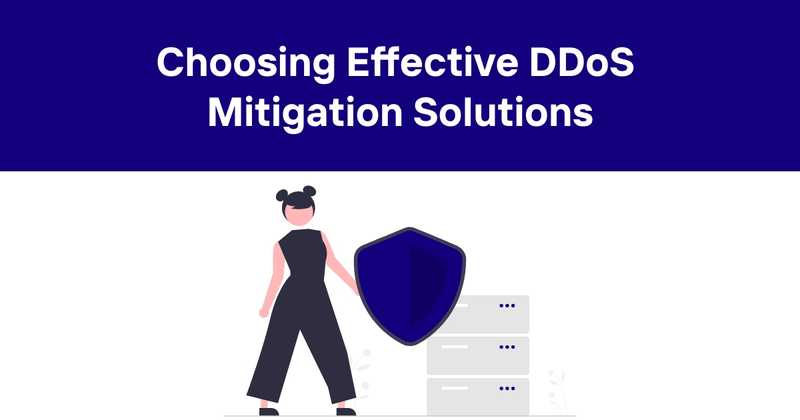Choosing Effective DDoS Mitigation Solutions
In the digital age, Distributed Denial of Service (DDoS) attacks have become a significant threat to online businesses and organizations. These attacks can cripple websites, disrupt services, and cause substantial financial losses. This article delves into the world of DDoS mitigation, exploring strategies and techniques to safeguard your online assets against these malicious attacks.
Table of Contents
- Understanding DDoS Attacks
- The Importance of DDoS Mitigation
- Types of DDoS Attacks
- DDoS Mitigation Strategies
- Choosing a DDoS Mitigation Provider
- Implementing DDoS Mitigation
- The Role of Content Delivery Networks (CDNs)
- Best Practices for DDoS Mitigation
- The Future of DDoS Mitigation
- Conclusion
Understanding DDoS Attacks
DDoS attacks are like a flood of unexpected guests showing up at your house all at once. Your poor doorway can't handle the traffic, and legitimate visitors can't get in. In the digital world, these "guests" are a barrage of traffic aimed at overwhelming a target's servers or network infrastructure.
The goal? To render the target's online services inaccessible to legitimate users. It's not just about inconvenience; these attacks can lead to significant financial losses, damage to reputation, and even long-term consequences for businesses.
The Importance of DDoS Mitigation
Why should you care about DDoS mitigation? Well, let me paint you a picture. Imagine you're running an online store, and suddenly, poof! Your website goes down during a big sale. Customers can't access your site, sales plummet, and your reputation takes a hit. That's the havoc a DDoS attack can wreak.
DDoS mitigation is your shield against these attacks. It's not just about keeping your site online; it's about maintaining customer trust, protecting your revenue, and ensuring business continuity. In today's digital landscape, it's not a question of if you'll face a DDoS attack, but when. Being prepared is no longer optional - it's a necessity.
Types of DDoS Attacks
DDoS attacks come in various flavors, each with its own nasty twist. Let's break them down:
-
Volumetric Attacks: These are the brutes of the DDoS world. They flood your network with a massive volume of traffic, clogging up your bandwidth like a hairball in a drain. Examples include UDP floods and ICMP floods.
-
Protocol Attacks: These sneaky attacks target server resources or intermediate communication equipment like firewalls. SYN floods and Ping of Death attacks fall into this category.
-
Application Layer Attacks: The most sophisticated of the bunch, these attacks target specific applications. They're like a wolf in sheep's clothing, mimicking legitimate user behavior to slip past defenses.
Understanding these types is crucial because each requires different mitigation strategies. It's like knowing your enemy - the first step to defeating them.
DDoS Mitigation Strategies
Now that we know what we're up against, let's talk strategy. DDoS mitigation isn't a one-size-fits-all solution. It's more like a toolbox, and you need to know which tool to use when.
1. Traffic Analysis and Filtering
This is your first line of defense. By analyzing incoming traffic patterns, you can identify and filter out malicious requests. It's like having a bouncer at a club, checking IDs and turning away troublemakers.
2. Rate Limiting
Rate limiting is all about setting thresholds. It restricts the number of requests a server will accept within a given timeframe. Think of it as putting a governor on a car - it keeps things from going too fast and spinning out of control.
3. Blackholing and Sinkholing
These techniques involve routing malicious traffic to a "black hole" or a sinkhole where it's effectively discarded. It's like diverting a river of trash away from your pristine lake.
4. Anycast Network Diffusion
This strategy distributes incoming traffic across a network of distributed servers. It's like having multiple entry points to a building instead of just one main door - it spreads out the load and makes it harder for attackers to overwhelm any single point.
5. Web Application Firewalls (WAF)
WAFs are like specialized bouncers for your web applications. They inspect incoming HTTP traffic and block suspicious activity before it reaches your server.
6. Scrubbing Centers
These are dedicated facilities that "scrub" incoming traffic, removing malicious packets before allowing the clean traffic through to its destination. It's like a car wash for your internet traffic - dirty traffic goes in, clean traffic comes out.
Choosing a DDoS Mitigation Provider
Selecting the right DDoS mitigation provider is crucial. It's not just about picking the biggest name or the cheapest option. You need a provider that fits your specific needs. Here are some factors to consider:
-
Network Capacity: The provider should have enough bandwidth to absorb large-scale attacks. It's like choosing a dam - you want one that can handle even the biggest floods.
-
Global Presence: A provider with a global network can better handle attacks from multiple geographic locations. It's about having eyes and ears everywhere.
-
Response Time: How quickly can the provider react to an attack? In DDoS mitigation, every second counts.
-
Customization Options: Your business is unique, and your DDoS protection should be too. Look for providers that offer customizable solutions.
-
Reporting and Analytics: Good providers offer detailed reports and analytics. This information is gold - it helps you understand attacks and improve your defenses.
-
Cost Structure: Understand the pricing model. Some providers charge a flat rate, while others bill based on usage or attack frequency.
-
Support: When you're under attack, you want a provider that's there for you. 24/7 support isn't just nice to have - it's essential.
Remember, choosing a DDoS mitigation provider is a bit like choosing a home security system. You want one that's reliable, effective, and suits your specific needs.
Implementing DDoS Mitigation
Implementing DDoS mitigation isn't just about flipping a switch. It's a process that requires planning and ongoing management. Here's a step-by-step approach:
-
Assessment: Start by assessing your current infrastructure and identifying vulnerabilities. It's like doing a security audit of your house - you need to know where the weak points are.
-
Planning: Develop a mitigation plan. This should include both proactive measures and reactive strategies for when an attack occurs.
-
Implementation: Deploy your chosen mitigation solutions. This might involve setting up hardware, configuring software, or integrating with a cloud-based service.
-
Testing: Regularly test your defenses. You wouldn't want to find out your alarm system doesn't work when there's an actual break-in, would you?
-
Monitoring: Set up continuous monitoring of your network. This helps you spot potential attacks early.
-
Incident Response Plan: Develop and regularly update an incident response plan. When an attack hits, you don't want to be scrambling to figure out what to do.
-
Staff Training: Ensure your team knows how to recognize and respond to DDoS attacks. Knowledge is power, especially in cybersecurity.
Remember, implementing DDoS mitigation is not a one-time task. It's an ongoing process that requires regular updates and improvements.
The Role of Content Delivery Networks (CDNs)
Content Delivery Networks (CDNs) play a crucial role in DDoS mitigation. They're like a distributed shield for your website, and they bring several benefits to the table:
-
Traffic Distribution: CDNs distribute your content across multiple servers worldwide. This makes it harder for attackers to target a single point of failure.
-
Improved Performance: By serving content from locations closer to users, CDNs can actually improve your website's performance. It's a win-win - better security and faster load times.
-
Absorption of Traffic Spikes: CDNs can absorb sudden spikes in traffic, whether they're from legitimate users or DDoS attacks.
-
Built-in Security Features: Many CDNs come with built-in security features, including DDoS protection.
Using a CDN is like having a network of fortified outposts protecting your main castle. They form a crucial part of a comprehensive DDoS mitigation strategy.
Best Practices for DDoS Mitigation
Implementing DDoS mitigation isn't just about having the right tools - it's about using them effectively. Here are some best practices to keep in mind:
-
Layer Your Defenses: Don't rely on a single mitigation technique. Use a combination of methods for the best protection.
-
Keep Software Updated: Regularly update all your software and systems. Outdated software can be a weak point in your defenses.
-
Use Intrusion Detection Systems (IDS): These systems can help you spot potential attacks early.
-
Implement Resource Limits: Set limits on system resources to prevent them from being overwhelmed during an attack.
-
Have a Backup Plan: Always have a backup of your critical data and systems. If an attack does get through, you want to be able to recover quickly.
-
Regular Security Audits: Conduct regular security audits to identify and address vulnerabilities.
-
Monitor Your Traffic: Keep a close eye on your network traffic. Unusual patterns could be a sign of an impending attack.
-
Educate Your Team: Make sure everyone in your organization understands the basics of DDoS attacks and how to respond.
Remember, DDoS mitigation is not a set-it-and-forget-it solution. It requires ongoing attention and adjustment.
The Future of DDoS Mitigation
As we look to the future, it's clear that DDoS attacks aren't going anywhere. In fact, they're likely to become more sophisticated and powerful. But don't worry - DDoS mitigation techniques are evolving too.
Here are some trends to watch:
-
AI and Machine Learning: These technologies are becoming increasingly important in identifying and mitigating DDoS attacks in real-time.
-
5G Networks: The rollout of 5G networks will bring new challenges and opportunities for DDoS mitigation.
-
IoT Security: As more devices connect to the internet, securing the Internet of Things (IoT) will become crucial in preventing DDoS attacks.
-
Edge Computing: Edge computing could help mitigate DDoS attacks by processing data closer to its source, reducing the attack surface.
-
Blockchain Technology: Some experts believe blockchain could play a role in future DDoS mitigation strategies.
The future of DDoS mitigation is about staying one step ahead of the attackers. It's an ongoing chess game, and the stakes are high.
Conclusion
DDoS attacks are a serious threat in today's digital landscape. But with the right mitigation strategies, you can protect your online assets and ensure business continuity. Remember, DDoS mitigation isn't just about having the right tools - it's about using them effectively and staying vigilant.
As we've explored, DDoS mitigation involves a multi-faceted approach, from traffic analysis and filtering to leveraging CDNs and implementing best practices. It's an ongoing process that requires regular attention and updates.
For those looking for a comprehensive solution to monitor website uptime, track SSL certificates, and manage public status pages, Odown.com offers a powerful set of tools. With Odown, you can keep a vigilant eye on your online assets, ensuring they're protected against DDoS attacks and other threats.
Odown's website uptime monitoring tool alerts you instantly if your site goes down, allowing you to respond quickly to potential DDoS attacks. The SSL certificate monitoring feature ensures your site's security remains intact, a crucial aspect of maintaining trust with your users. And with public status pages, you can keep your users informed during any incidents, maintaining transparency and trust.
In the fight against DDoS attacks, knowledge and preparedness are your best weapons. Stay informed, stay prepared, and don't hesitate to leverage tools like Odown to keep your online presence secure and reliable.



